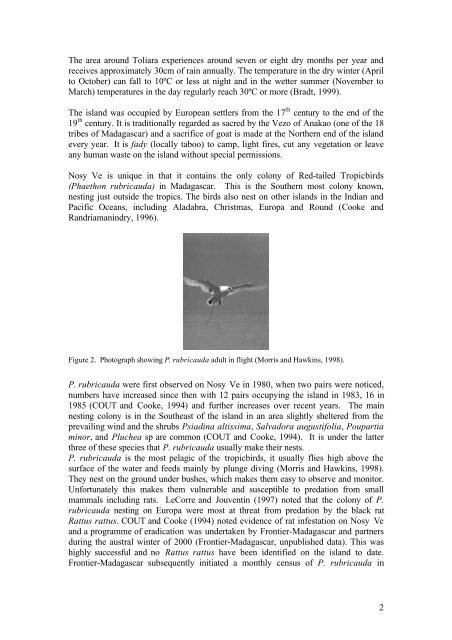Monitoring of the red tailed tropic bird - Frontier-publications.co.uk
Monitoring of the red tailed tropic bird - Frontier-publications.co.uk
Monitoring of the red tailed tropic bird - Frontier-publications.co.uk
Create successful ePaper yourself
Turn your PDF publications into a flip-book with our unique Google optimized e-Paper software.
The area around Toliara experiences around seven or eight dry months per year and<br />
receives approximately 30cm <strong>of</strong> rain annually. The temperature in <strong>the</strong> dry winter (April<br />
to October) can fall to 10ºC or less at night and in <strong>the</strong> wetter summer (November to<br />
March) temperatures in <strong>the</strong> day regularly reach 30ºC or more (Bradt, 1999).<br />
The island was occupied by European settlers from <strong>the</strong> 17 th century to <strong>the</strong> end <strong>of</strong> <strong>the</strong><br />
19 th century. It is traditionally regarded as sac<strong>red</strong> by <strong>the</strong> Vezo <strong>of</strong> Anakao (one <strong>of</strong> <strong>the</strong> 18<br />
tribes <strong>of</strong> Madagascar) and a sacrifice <strong>of</strong> goat is made at <strong>the</strong> Nor<strong>the</strong>rn end <strong>of</strong> <strong>the</strong> island<br />
every year. It is fady (locally taboo) to camp, light fires, cut any vegetation or leave<br />
any human waste on <strong>the</strong> island without special permissions.<br />
Nosy Ve is unique in that it <strong>co</strong>ntains <strong>the</strong> only <strong>co</strong>lony <strong>of</strong> Red-<strong>tailed</strong> Tropic<strong>bird</strong>s<br />
(Phaethon rubricauda) in Madagascar. This is <strong>the</strong> Sou<strong>the</strong>rn most <strong>co</strong>lony known,<br />
nesting just outside <strong>the</strong> <strong>tropic</strong>s. The <strong>bird</strong>s also nest on o<strong>the</strong>r islands in <strong>the</strong> Indian and<br />
Pacific Oceans, including Aladabra, Christmas, Europa and Round (Cooke and<br />
Randriamanindry, 1996).<br />
Figure 2. Photograph showing P. rubricauda adult in flight (Morris and Hawkins, 1998).<br />
P. rubricauda were first observed on Nosy Ve in 1980, when two pairs were noticed,<br />
numbers have increased since <strong>the</strong>n with 12 pairs occupying <strong>the</strong> island in 1983, 16 in<br />
1985 (COUT and Cooke, 1994) and fur<strong>the</strong>r increases over recent years. The main<br />
nesting <strong>co</strong>lony is in <strong>the</strong> Sou<strong>the</strong>ast <strong>of</strong> <strong>the</strong> island in an area slightly shelte<strong>red</strong> from <strong>the</strong><br />
prevailing wind and <strong>the</strong> shrubs Psiadina altissima, Salvadora augustifolia, Poupartia<br />
minor, and Pluchea sp are <strong>co</strong>mmon (COUT and Cooke, 1994). It is under <strong>the</strong> latter<br />
three <strong>of</strong> <strong>the</strong>se species that P. rubricauda usually make <strong>the</strong>ir nests.<br />
P. rubricauda is <strong>the</strong> most pelagic <strong>of</strong> <strong>the</strong> <strong>tropic</strong><strong>bird</strong>s, it usually flies high above <strong>the</strong><br />
surface <strong>of</strong> <strong>the</strong> water and feeds mainly by plunge diving (Morris and Hawkins, 1998).<br />
They nest on <strong>the</strong> ground under bushes, which makes <strong>the</strong>m easy to observe and monitor.<br />
Unfortunately this makes <strong>the</strong>m vulnerable and susceptible to p<strong>red</strong>ation from small<br />
mammals including rats. LeCorre and Jouventin (1997) noted that <strong>the</strong> <strong>co</strong>lony <strong>of</strong> P.<br />
rubricauda nesting on Europa were most at threat from p<strong>red</strong>ation by <strong>the</strong> black rat<br />
Rattus rattus. COUT and Cooke (1994) noted evidence <strong>of</strong> rat infestation on Nosy Ve<br />
and a programme <strong>of</strong> eradication was undertaken by <strong>Frontier</strong>-Madagascar and partners<br />
during <strong>the</strong> austral winter <strong>of</strong> 2000 (<strong>Frontier</strong>-Madagascar, unpublished data). This was<br />
highly successful and no Rattus rattus have been identified on <strong>the</strong> island to date.<br />
<strong>Frontier</strong>-Madagascar subsequently initiated a monthly census <strong>of</strong> P. rubricauda in<br />
2
















